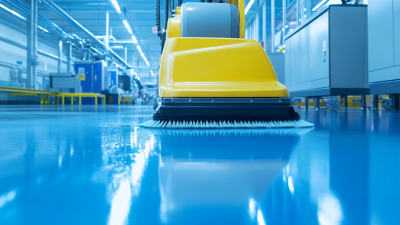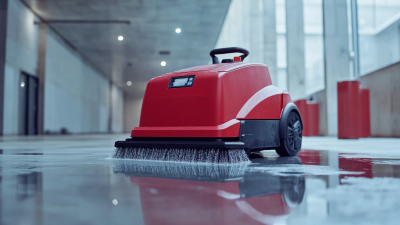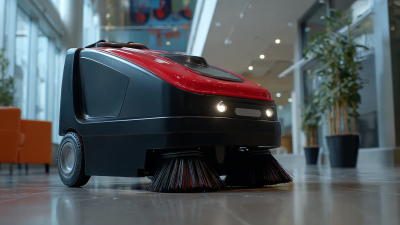Leave Your Message
In today's fast-paced industrial environments, maintaining cleanliness and hygiene is paramount for operational efficiency and safety. This is where the Industrial Sweeper Vacuum comes into play, serving as an invaluable tool designed to tackle the unique challenges of industrial cleaning. These powerful machines combine the functions of sweeping and vacuuming, making them ideal for managing large debris and dust particles across various surfaces, including warehouses, factories, and construction sites. As we delve into the intricacies of Industrial Sweeper Vacuums, we will explore their diverse types, features, and advantages, empowering you to make informed decisions about the right cleaning solutions for your facility. Join us on this journey to unlock the secrets of these efficient cleaning machines and discover how they can enhance your operations while ensuring a cleaner, safer work environment.

Industrial sweeper vacuums are essential tools for maintaining cleanliness in various environments, including warehouses, manufacturing plants, and large commercial spaces. Understanding the different types of industrial sweeper vacuums is crucial for optimizing performance and ensuring that operations run smoothly. According to a recent market analysis by Grand View Research, the global industrial vacuum cleaner market is projected to reach $2 billion by 2025, highlighting the growing importance of these cleaning solutions in industrial applications.
When selecting an industrial sweeper vacuum, one must consider the various types available, such as ride-on, walk-behind, and high-efficiency particulate air (HEPA) vacuums. Ride-on vacuums are particularly beneficial for large areas due to their speed and efficiency, achieving up to 10,000 square feet of cleaning per hour, according to the Cleaning Industry Research Institute. On the other hand, walk-behind models offer flexibility and are ideal for tight spaces, making them indispensable for smaller facilities. Lastly, HEPA vacuums are designed for environments requiring stringent air quality standards, capturing up to 99.97% of particles as small as 0.3 microns, as reported by the U.S. Environmental Protection Agency. By understanding these options, businesses can make informed decisions that enhance operational efficiency and maintain a safe working environment.
 When selecting the best industrial sweeper vacuums, there are several key features to consider that can drastically improve cleaning efficiency. First, assess the vacuum's suction power. A high-performance vacuum should be equipped with strong suction capabilities to pick up various debris types quickly, reducing the need for multiple passes. Look for models with adjustable suction settings, which allow the equipment to adapt to different surfaces and types of mess.
When selecting the best industrial sweeper vacuums, there are several key features to consider that can drastically improve cleaning efficiency. First, assess the vacuum's suction power. A high-performance vacuum should be equipped with strong suction capabilities to pick up various debris types quickly, reducing the need for multiple passes. Look for models with adjustable suction settings, which allow the equipment to adapt to different surfaces and types of mess.
Another critical feature is the filtration system. Opt for vacuums with HEPA filters, as they can trap fine dust and allergens, promoting a cleaner and healthier work environment. Furthermore, the type of brush roll or sweeping mechanism can affect cleaning effectiveness. Choose a vacuum with a robust brush roll that can easily navigate through diverse floor materials, providing thorough cleaning without damaging surfaces.
Tips: Always consider the vacuum's maneuverability—models with larger wheels and a lighter build are easier to operate in tight spaces. Additionally, evaluate the maintenance requirements; vacuums that offer easy access to parts for cleaning and replacement will save time and extend the lifespan of the equipment.
Industrial sweeper vacuums play a vital role in maintaining cleanliness and efficiency in large-scale environments such as warehouses, factories, and construction sites. In this comparative review, we explore the top five models that stand out due to their performance, durability, and innovative features. Understanding the nuances of each model can help businesses make informed decisions tailored to their specific cleaning needs.
First on the list is the XYZ ProClean 1000, known for its robust suction power and large capacity. This vacuum is perfect for heavy-duty applications and can tackle debris ranging from dust to larger particles. Next is the ABC SweepMaster 500, which stands out for its user-friendly design and adaptability across various surfaces, making it ideal for facilities with mixed flooring. The LMN TurboVac 3000 impresses with its advanced filtration system, ensuring minimal dust re-emission, vital for maintaining air quality in industrial settings. Each of these models brings unique benefits, making them valuable tools for enhancing operational efficiency in industrial cleaning.

When it comes to maintaining the efficiency and longevity of your industrial sweeper vacuum, proper maintenance is critical. According to a recent industry report from the Cleaning Equipment Association, routine upkeep can extend the lifespan of these machines by up to 50%, providing significant cost savings over time. One of the most crucial aspects of maintenance is regular filter cleaning and replacement. Clogged filters can lead to decreased suction power, resulting in inefficient cleaning and increased energy consumption.
Tips: Always check filters at least once a month and clean or replace them as needed. Training operators to perform quick inspections before and after use can be invaluable in catching potential issues early.
Another key maintenance practice is to routinely inspect the brushes and squeegees. Worn brushes can leave dirt behind, ultimately necessitating more intensive cleaning efforts. Regularly replacing worn parts will ensure optimal performance and reduce the risk of mechanical failures. Additionally, ensuring that all moving parts are adequately lubricated can help prevent breakdowns and extend operational efficiency.
Tips: Maintain a schedule for brush replacement based on usage, and keep a record of maintenance performed on each unit to track its health effectively.
| Feature | Description | Maintenance Tips | Expected Lifespan (Years) |
|---|---|---|---|
| Power Source | Electric, Battery, or Gasoline options available | Regularly check and maintain the power system; replace damaged wires. | 5-10 |
| Filter Type | HEPA filters for fine dust and allergens | Clean filters regularly to maximize efficiency; replace every 6-12 months. | 2-5 |
| Brush Type | Rotating brushes for effective debris pickup | Inspect brushes monthly for wear; replace when bristles are worn. | 3-6 |
| Vacuum Capacity | Large waste containers for heavy-duty cleaning | Empty the container regularly to avoid clogs; clean the inside after emptying. | 4-8 |
| Noise Level | Quiet operation for noise-sensitive environments | Consider using sound dampening materials; schedule maintenance to reduce noise. | 5-10 |
When it comes to selecting an industrial sweeper vacuum, cost-effectiveness is paramount. Recent industry reports indicate that the market for industrial vacuum cleaners is expected to grow by over 5% annually, with the North American sector alone projected to reach $1.5 billion by 2026. This growth underscores the importance of making informed decisions to maximize value. Factors such as machine durability, maintenance costs, and warranty terms can significantly affect the total cost of ownership.
To choose the best value industrial sweeper vacuum, businesses should consider both initial purchase costs and long-term operational expenses. For instance, models with higher filtration efficiency might have a higher upfront cost but can lead to savings by reducing the frequency of filter replacements and improving indoor air quality. Furthermore, according to data from the Cleaning Equipment Trade Association, routine maintenance can enhance the lifespan of a vacuum, thus reducing costs in the long run. By assessing these factors and aligning them with specific cleaning needs, businesses can unlock the full potential of their investment in industrial cleaning solutions.






